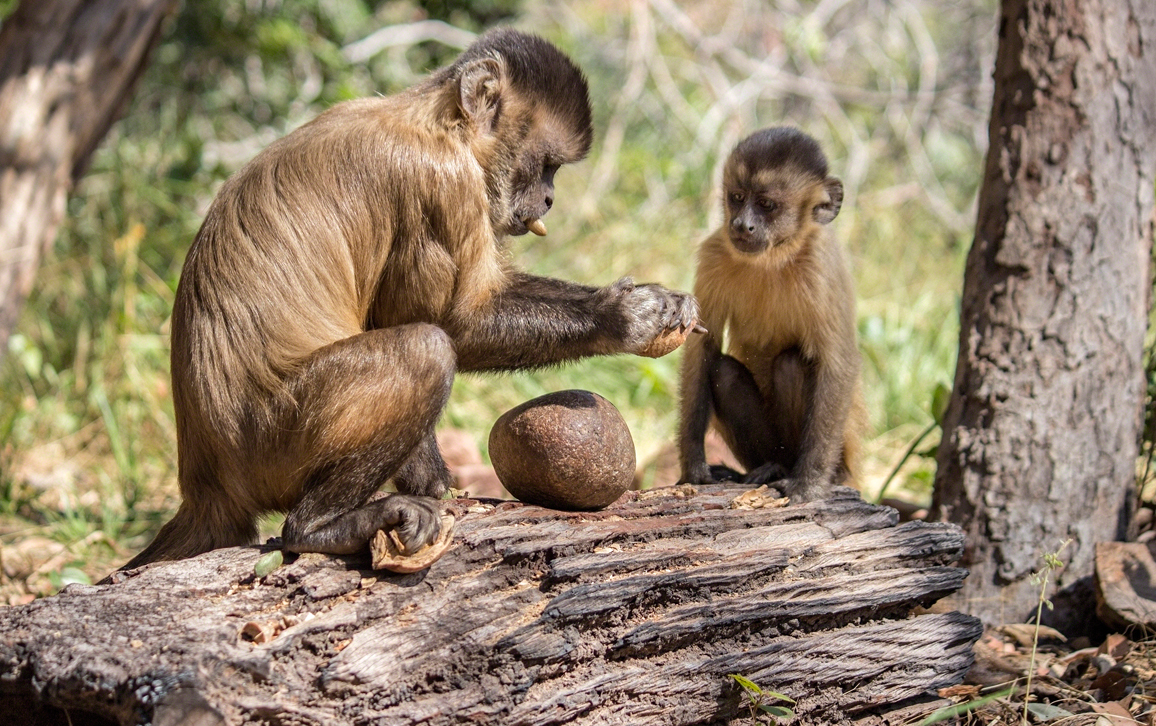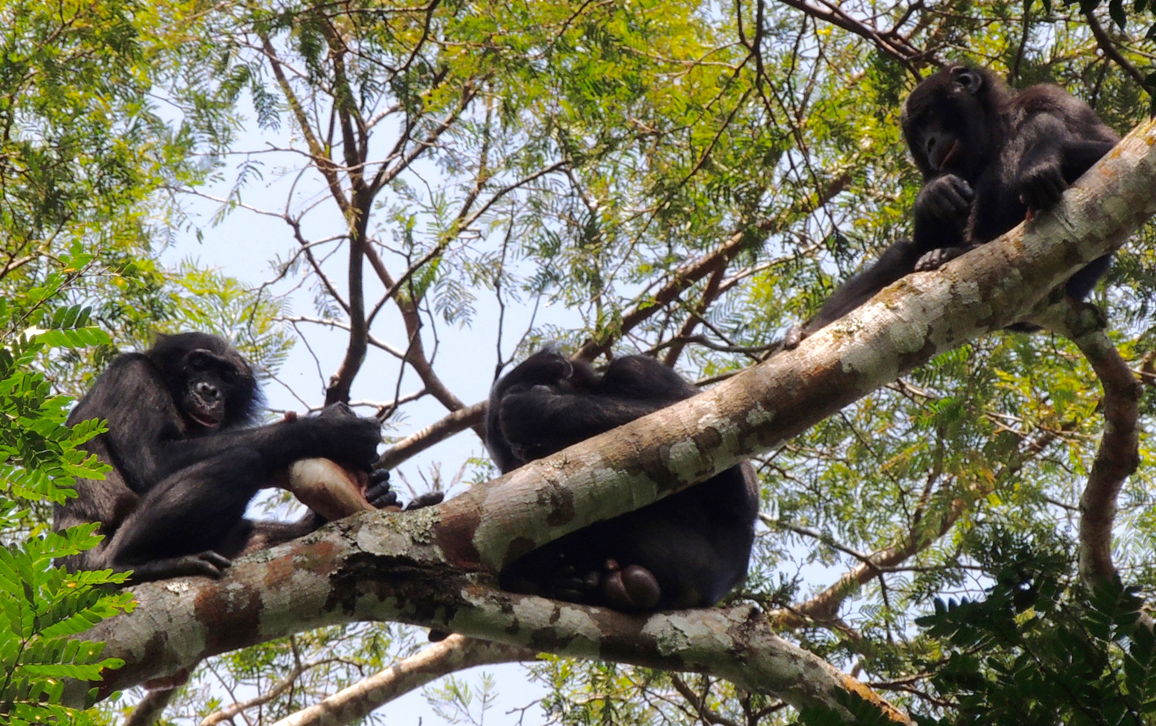A Buffet of Primate Studies
By Sandra J. Ackerman
Brief presentations hint at the insights to be gleaned from a cornucopia of anthropological research.
Brief presentations hint at the insights to be gleaned from a cornucopia of anthropological research.

At a recent meeting of the American Association of Physical Anthropologists (AAPA), research groups presented studies that ranged from searching for signs of handedness in nonhuman primates to documenting unexpected materials in the primate diet. What follows is a small sampling of the many appealing projects discussed at that gathering.
Sometime around their first birthday, human babies begin to show signs of handedness, the habitual preference for using one hand rather than the other. This preference may change for different tasks, but over the next several years it settles into a fixed choice. Yet other primates that use their hands like us, for all kinds of purposes, don’t exhibit this trait to anything like the extent seen in humans.
Among our closest living relatives, the chimpanzees (Pan troglodytes), some individuals may demonstrate a preference to use one hand or the other, but only for a particular task.
Working with Linda Marchant at the Miami University of Ohio and Robert O’Malley of George Washington University, undergraduates Emma Brzezinski and Nicole Schapker sifted through this behavior for evidence of any latent handedness. Using the Noldus software program, they analyzed about 50 hours of video footage of termite fishing from Gombe National Park in Tanzania. “In general, the more demanding a task is in cognitive terms, the more likely chimpanzees are to show a preference for using one hand or the other,“ Brzezinski says, but this inclination appeared only in slightly more than half the chimps studied. The tendency seems to fall short of widespread, innate handedness.

Luca Antonio Marino
As for monkeys, one of the real standouts is the tufted capuchin (Sapajus spp.), the only New World monkey that habitually uses tools to obtain food. Tufted capuchins use sharp stones to dig for edible tubers and poke sticks into insect nests to extract prey. Psychologist and primatologist Dorothy Fragaszy of the University of Georgia has also seen tufted capuchins employing two rocks as a hammer and anvil to crack tough-shelled nuts. Individual monkeys typically prefer to use one hand or the other for a particular action; however, they may prefer different hands for different actions. As a population, they are not predominantly right-handed, as humans are.
Lemurs, too, are even-handed in their foraging, according to a presentation by Carly Batist of Central Washington University. In research for her master’s thesis, Batist carried out observations at the Duke Lemur Center in Durham, North Carolina, focusing on species that each occupy a distinct ecological and social niche: For example, sifakas (Propithecus spp.) prefer to eat leaves, whereas ruffed lemurs (Varecia spp.) eat mainly fruit; ring-tailed lemurs (Lemur catta) usually band together in large groups of up to 30 members, whereas various species of the so-called true lemur (Eulemur spp.) live in small, nuclear-family clusters.
Most of Batist’s research centered on a food-dispensing station within the lemur habitat. Batist watched as the lemurs learned to open a door and then grab the food. “Often they started out poking at it with both hands at random, but when either the right or the left hand finally succeeded in getting hold of food, the lemur then developed a preference for whichever hand was used on the first success,” she says.
Some individuals kept their two-handed approach when feeding at the station, but most ultimately came to use one hand or the other. Curiously, within family groups and within species, right- and left-handers more or less canceled each other out. As with any primates, though, some allowance must be made for sheer eccentricity. “Quite a few of them, especially the sifakas and ruffed lemurs, just stuck their whole face inside the device and used their mouths to retrieve the food,” says Batist. “That worked roughly as well as using a hand.”
At the Las Piedras Biodiversity Station, in the Peruvian Amazon, researchers tried a new type of feeding station in an ongoing quest for better ways to collect data on animal behavior in the wild. This station uses solar power, with five or six hours of sunlight exposure providing enough electricity to keep it running for more than 24 hours. While enticing animals with fresh food, the station takes photographs and records the time, date, temperature, and humidity. The camera is activated by a motion sensor that covers a very small area—less than a meter square—to focus on the individuals that are actually feeding, as opposed to those that approach the device but do not come close enough to take food from it.
This ingenious device is the work of Conner Philson, an undergraduate at Radford University in Virginia. Philson points out that the device could also be applied in other kinds of research where continuous monitoring is desirable but not practicable by humans; in fact, he originally developed it to monitor the behavior of songbirds. (Hence its name, the PASSER Project, for Programmable Automated System for Songbird Ecological Research.) Data collection was scant because nonhuman primates in the area kept a wary distance while the device was in place, but the two-week trial period demonstrated that the feeding station could withstand tropical weather and everyday wear and tear.
When it comes to eating, feeding stations and observatories can tell only part of the story. Food has attributes that may be extraneous to the food but are ingested nevertheless, such as tiny mineral particles that are found in the dust and dirt stuck on foods. Over a lifetime, such abrasive particles have the potential to wear down teeth significantly and may therefore impart a significant selection pressure on an animal’s diet. As postdoctoral fellow Adam van Casteren explains, “An animal that can’t use its teeth is in serious trouble.”
Perhaps haunted by the memory of an overly gritty sandwich from a long-ago picnic, van Casteren set out to study such extraneous material on the fruits and leaves eaten by chimps in a region of eastern Africa. Thanks to the varied habitat of the eastern chimpanzee (P. troglodytes schweinfurthii), which includes both the savannah woodland of Tanzania and the rainforest of Uganda, van Casteren was presented with a natural experiment: comparing the extraneous particles deposited on food in a relatively dry, open savannah woodland with those on the food in a moist, close-growing tropical rainforest.

Photo courtesy of Monica Wakefield.
Together with colleagues from the Max Planck Institute for Evolutionary Anthropology, van Casteren collected samples of the chimpanzee diet from both habitats and coated them with a thin layer of plastic, which when peeled off brought with it any extraneous particles from the surface of the food. They were surprised to find that food from the dry savannah tended to have less extraneous material on its surface than that from the rainforest.
The reasons for this discrepancy aren’t entirely clear, but the researchers speculate that with less wind moving through the dense rainforest, particles might be able to build up on surfaces more easily. In addition, says van Casteren, “Rain can clear away dust, but it also brings dust, depositing the fine mineral particles we found.”
No review of primate research is complete without a mention of food-sharing. Under this heading, Monica Wakefield of Northern Kentucky University had news to report about bonobos (Pan paniscus), the more gracile, less aggressive cousins of chimpanzees. Although they have a popular image as peaceable vegetarians, bonobos have recently been seen eating meat—and squabbling over it, too.
Bonobos haven’t been observed engaging in coordinated stalking or hunting, but a bonobo that acquires meat is soon mobbed by others pleading for a share of the treat.
Why is begging for food, and particularly for meat, such a widespread behavior? Wakefield wonders whether the explanation may rest more on social dynamics than on food value. “The assessing relationships hypothesis—originally offered by Colleen Stephens and her colleagues at the Max Planck Institute for Evolutionary Anthropology—proposes that, since begging consumes more time and energy than is compensated in nutrition, its real value may lie in what it reveals about relative social status,” she says. In this connection, a report of food-sharing between two different troops of bonobos—which was posted on the eve of the AAPA meeting (Human Nature, April 5)—raises yet more intriguing questions that will take some time to explore in full.
Click "American Scientist" to access home page
American Scientist Comments and Discussion
To discuss our articles or comment on them, please share them and tag American Scientist on social media platforms. Here are links to our profiles on Twitter, Facebook, and LinkedIn.
If we re-share your post, we will moderate comments/discussion following our comments policy.